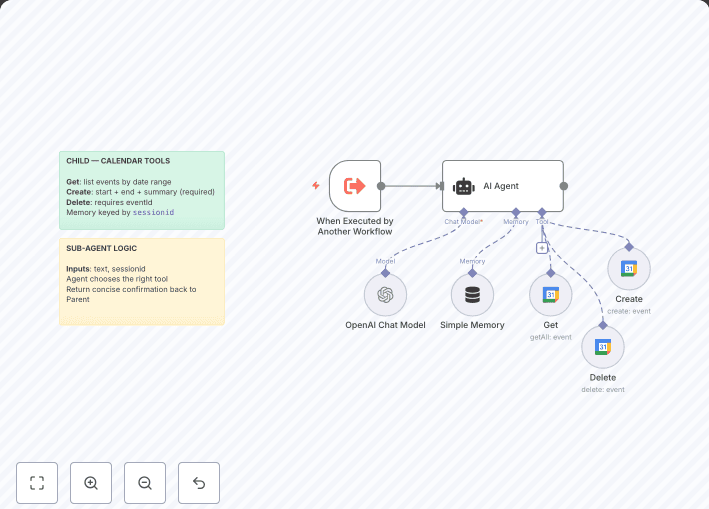Pull a Dun & Bradstreet Business Information Report (PDF) by DUNS, convert the response into a binary PDF file , extract readable text, and use OpenAI to return a clean, flat JSON with only the key fields you care about (e.g., report date, Paydex, viability score, credit limit). Includes Sticky Notes for quick setup help and guidance.
✅ What this template does
- Requests a D &B report (PDF) for a specific DUNS via HTTP
- Converts the API response into a binary PDF file
- Extracts the text from the PDF for analysis
- Uses OpenAI with a Structured Output Parser to return a flat JSON
- Designed to be extended to Sheets, databases, or CRMs
🧩 How it works (node-by-node)
- Manual Trigger — Runs the workflow on demand ("When clicking 'Execute workflow'").
- D &B Report (HTTP Request) — Calls the D&B Reports API for a Business Information Report (PDF).
- Convert to PDF File (Convert to File) — Turns the D&B response payload into a binary PDF.
- Extract Binary (Extract from File) — Extracts text content from the PDF.
- OpenAI Chat Model — Provides the language model context for the analyzer.
- Analyze PDF (AI Agent) — Reads the extracted text and applies strict rules for a flat JSON output.
- Structured Output (AI Structured Output Parser) — Enforces a schema and validates/auto-fixes the JSON shape.
- (Optional) Get Bearer Token (HTTP Request) — Template guidance for OAuth token retrieval (shown as disabled; included for reference if you prefer Bearer flows).
🛠️ Setup instructions (from the JSON)
1) D&B Report (HTTP Request)
Put your Authorization: Bearer <token> header inside this credential, not directly in the node.
2) Convert to PDF File (Convert to File)
- Operation:
toBinary
- Source Property:
contents[0].contentObject
This takes the PDF content from the D&B API response and converts it to a binary file for downstream nodes.
3) Extract Binary (Extract from File)
Produces a text field with the extracted PDF content, ready for AI analysis.
4) OpenAI Model(s)
- OpenAI Chat Model
- Model:
gpt-4o (as configured in the JSON)
- Credential: Your stored OpenAI API credential (do not hardcode keys)
- Wiring:
- Connect OpenAI Chat Model as
ai_languageModel to Analyze PDF
- Connect another OpenAI Chat Model (also
gpt-4o) as ai_languageModel to Structured Output
5) Analyze PDF (AI Agent)
- Prompt Type:
define
- Text:
={{ $json.text }}
- System Message (rules):
- You are a precision extractor. Read the provided business report PDF and return only a single flat JSON object with the fields below.
- No arrays/lists.
- No prose.
- If a value is missing, output null.
- Dates:
YYYY-MM-DD.
- Numbers: plain numerics (no commas or $).
- Prefer most recent or highest-level overall values if multiple are shown.
- Never include arrays, nested structures, or text outside of the JSON object.
6) Structured Output (AI Structured Output Parser)
-
JSON Schema Example:
{
"report_date": "",
"company_name": "",
"duns": "",
"dnb_rating_overall": "",
"composite_credit_appraisal": "",
"viability_score": "",
"portfolio_comparison_score": "",
"paydex_3mo": "",
"paydex_24mo": "",
"credit_limit_conservative": ""
}
-
Auto Fix: enabled
-
Wiring: Connect as ai_outputParser to Analyze PDF
7) (Optional) Get Bearer Token (HTTP Request) — Disabled example
If you prefer fetching tokens dynamically:
- Auth: Basic Auth (D&B username/password)
- Method: POST
- URL: https://plus.dnb.com/v3/token
- Body Parameters:
grant_type = client_credentials
- Headers:
- Downstream usage: Set header
Authorization: Bearer {{$json["access_token"]}} in subsequent calls.
In this template, the D&B Report node uses Header Auth credential instead. Use one strategy consistently (credentials are recommended for security).
🧠 Output schema (flat JSON)
The analyzer + parser return a single flat object like:
{
"report_date": "2024-12-31",
"company_name": "Example Corp",
"duns": "123456789",
"dnb_rating_overall": "5A2",
"composite_credit_appraisal": "Fair",
"viability_score": "3",
"portfolio_comparison_score": "2",
"paydex_3mo": "80",
"paydex_24mo": "78",
"credit_limit_conservative": "25000"
}
🧪 Test flow
- Click Execute workflow (Manual Trigger).
- Confirm D &B Report returns the PDF response.
- Check Convert to PDF File for a binary file.
- Verify Extract from File produces a
text field.
- Inspect Analyze PDF → Structured Output for valid JSON.
🔐 Security notes
- Do not hardcode tokens in nodes; use Credentials (HTTP Header Auth or Basic Auth).
- Restrict who can execute the workflow if it's accessible from outside your network.
- Avoid storing sensitive payloads in logs; mask tokens/headers.
🧩 Customize
- Map the structured JSON to Google Sheets , Postgres/BigQuery , or a CRM.
- Extend the schema with additional fields (e.g., number of employees, HQ address) — keep it flat.
- Add validation (Set/IF nodes) to ensure required fields exist before writing downstream.
🩹 Troubleshooting
- Missing PDF text? Ensure Convert to File source property is
contents[0].contentObject.
- Unauthorized from D &B? Refresh/verify token; confirm Header Auth credential contains
Authorization: Bearer <token>.
- Parser errors? Keep the agent output short and flat; the Structured Output node will auto-fix minor issues.
- Different DUNS/product? Update the D&B Report URL query params (
duns, productId, etc.).
🗒️ Sticky Notes (included)
- Overview: "Fetch D&B Company Report (PDF) → Convert → Extract → Summarize to Structured JSON (n8n)"
- Setup snippets for Data Blocks (optional) and Auth flow
📬 Contact
Need help customizing this (e.g., routing the PDF to Drive, mapping JSON to your CRM, or expanding the schema)?
📧 [email protected]
🔗 https://www.linkedin.com/in/robert-breen-29429625/
🌐 https://ynteractive.com


